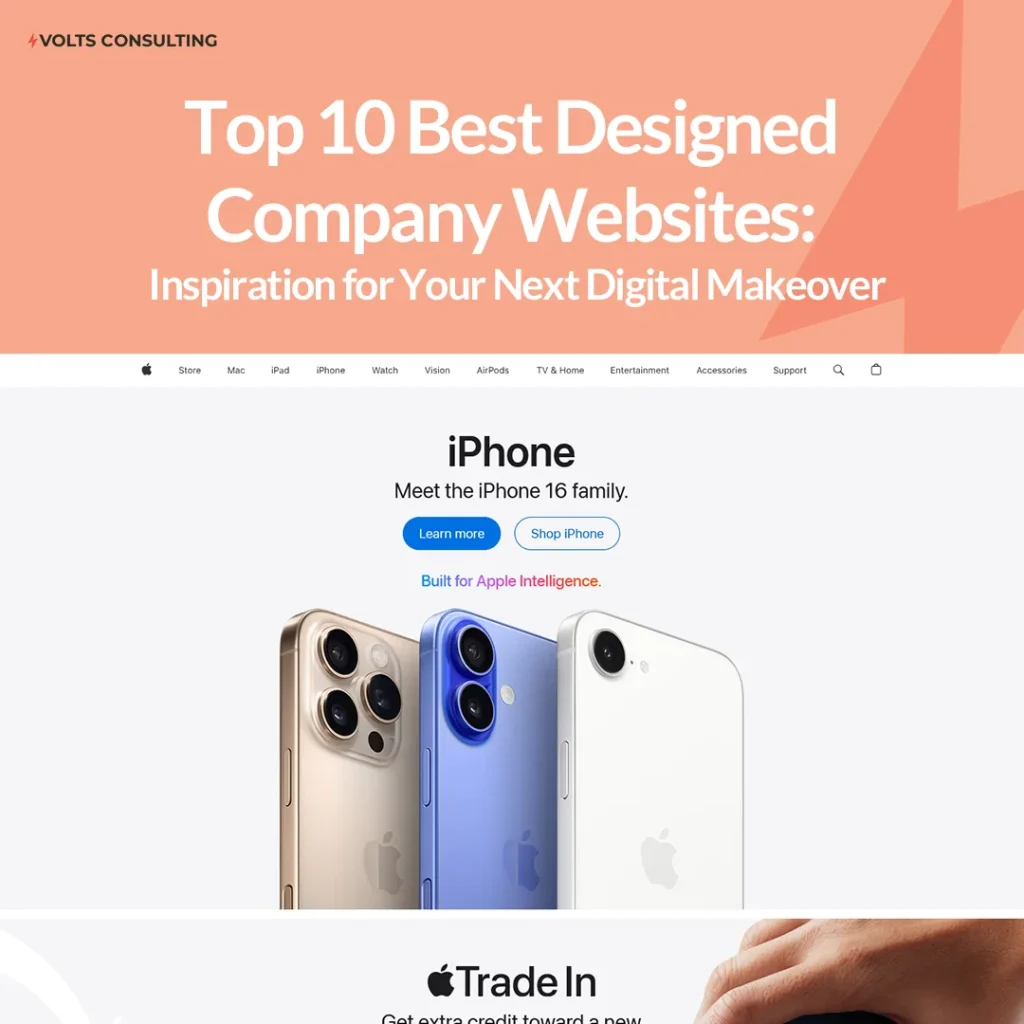In today’s digital age, a company’s website is often the first impression potential customers receive. A well-designed website not only enhances brand identity but also fosters trust and encourages user engagement. With the right combination of aesthetics, functionality, and innovative design elements, your website can transform into a powerful tool that drives conversions and elevates your business.
In this article, we delve into the top 10 best-designed company websites that set the standard for excellence in web design. These noteworthy examples showcase unique approaches to layout, color schemes, and user experience, providing fresh inspiration for your next digital makeover. Whether you’re looking to revamp an existing site or starting from scratch, these design gems will spark your creativity and help you envision the endless possibilities for your online presence. Join us as we explore what makes these websites stand out and how you can apply their success strategies to your own digital endeavors.

Importance of a Well-Designed Website
A well-designed website is more than just an online presence; it’s a powerful tool that can make or break a business in today’s digital era. The first impression matters immensely, and a visually appealing website can captivate potential customers at first glance. Beyond aesthetics, a well-structured site promotes ease of navigation, which is essential for retaining visitors and guiding them toward desired actions, whether it be making a purchase, signing up for a newsletter, or simply learning more about your offerings.
Moreover, a thoughtfully designed website enhances brand credibility. In a world where consumers are bombarded with choices, trust plays a pivotal role in decision-making. A professional, user-friendly website signals to visitors that your business is reliable, up-to-date, and customer-focused. This trust often translates into higher engagement rates, increased time spent on the site, and ultimately, better conversion rates.
Additionally, a well-crafted website is a reflection of your brand identity. It communicates your values, mission, and personality to the audience. Consistent use of color schemes, typography, and imagery helps build a strong brand image and makes your business memorable. In this way, the design of your website can be a strategic asset that differentiates you from competitors and fosters brand loyalty.
###
Criteria for Evaluating Website Design
Evaluating website design involves several key criteria that go beyond just visual appeal. One of the primary factors is usability, which encompasses how easily users can navigate the site and find the information they need. A user-friendly interface with intuitive navigation, clear calls to action, and a seamless flow significantly enhances the user experience and keeps visitors engaged.
Another critical criterion is responsiveness. In an age where users access websites from various devices, including smartphones, tablets, and desktops, it’s imperative that your website adapts seamlessly to different screen sizes. Responsive design ensures that all users, regardless of the device they’re using, have an optimal viewing experience without frustrating pinch-and-zoom or horizontal scrolling.
Speed and performance also play a crucial role in website design. Long loading times can deter visitors and increase bounce rates. A well-designed website should be optimized for speed, with efficiently loaded elements and minimized use of heavy graphics or scripts. Additionally, accessibility is an essential aspect, ensuring that the site is usable by people with disabilities, which not only broadens your audience but also demonstrates inclusivity and social responsibility.
###
Top 10 Best Designed Company Websites
####
1. Apple
Apple’s website is a masterclass in simplicity and elegance. The design reflects the brand’s minimalist aesthetic, with clean lines, ample white space, and high-quality imagery that showcases its products beautifully. The intuitive navigation and seamless user experience make it easy for visitors to explore products, learn about features, and make purchases effortlessly. The site is also highly responsive, providing an excellent experience across all devices.
####
2. Airbnb
Airbnb’s website stands out for its vibrant visuals and engaging storytelling. The homepage features stunning photographs of destinations, inviting users to dream about their next travel adventure. The site uses a clever mix of typography and color to guide users through the booking process. Additionally, the user interface is exceptionally intuitive, making it easy for visitors to search for accommodations, read reviews, and book stays with confidence.
####
3. Dropbox
Dropbox’s website exemplifies the power of simplicity and clarity. The design is clean and uncluttered, with a focus on functionality and user experience. The homepage uses effective visual hierarchy to highlight the core benefits of the service, while clear calls to action guide users towards signing up or downloading the app. The site also features engaging animations that add a touch of dynamism without overwhelming the user.
####
4. Squarespace
Squarespace’s website is a testament to the company’s expertise in web design. The site is visually stunning, with a sleek and modern aesthetic that showcases the capabilities of its platform. High-quality images, bold typography, and a well-structured layout make it easy for visitors to understand the value proposition. The site also features interactive elements that enhance engagement, such as video backgrounds and smooth scrolling effects.
####
5. Slack
Slack’s website is designed with a focus on user engagement and conversion. The homepage features vibrant colors, playful illustrations, and concise messaging that clearly communicates the benefits of the platform. The site is easy to navigate, with prominent calls to action that guide users towards signing up or exploring features. Additionally, the site includes case studies and testimonials that build credibility and trust.
####
6. Mailchimp
Mailchimp’s website is a perfect blend of creativity and functionality. The design uses bold colors, playful illustrations, and engaging animations to capture the user’s attention. The site is organized in a way that makes it easy for visitors to understand the service offerings and find the information they need. Clear calls to action and a well-structured layout guide users towards signing up or learning more about the platform.
####
7. Spotify
Spotify’s website is a prime example of how to create an immersive user experience. The site uses high-quality visuals, engaging animations, and a dynamic layout to draw users in. The homepage features bold typography and vibrant colors that reflect the brand’s energetic personality. The site is also highly responsive, providing a seamless experience across all devices. Additionally, the user interface is intuitive, making it easy for visitors to explore music, create playlists, and discover new artists.
####
8. Tesla
Tesla’s website is a showcase of innovation and cutting-edge design. The site features sleek visuals, high-quality images, and a minimalist aesthetic that aligns with the brand’s futuristic image. The homepage uses effective visual hierarchy to highlight key information about the products, while interactive elements enhance user engagement. The site is also optimized for performance, ensuring fast loading times and a smooth browsing experience.
####
9. Nike
Nike’s website is a dynamic and visually striking representation of the brand. The design uses bold imagery, vibrant colors, and engaging animations to create an immersive experience. The site is easy to navigate, with clear calls to action that guide users towards exploring products, reading stories, or making purchases. Additionally, the site features personalized content and recommendations, enhancing user engagement and driving conversions.
####
10. Adobe
Adobe’s website is a perfect example of how to balance creativity and functionality. The design is visually appealing, with high-quality images, bold typography, and a well-organized layout. The site effectively communicates the value of Adobe’s products and services, with clear calls to action and engaging content. Additionally, the site includes interactive elements, such as product demos and tutorials, that enhance user engagement and provide a deeper understanding of the offerings.
###
Key Features of Successful Website Designs
Successful website designs share several key features that contribute to their effectiveness. One of the most important features is a clear and compelling value proposition. This involves clearly communicating what the company offers and how it benefits the user. A strong value proposition helps capture the visitor’s attention and encourages them to explore further.
Another key feature is intuitive navigation. A well-designed website should make it easy for users to find the information they need without any frustration. This involves using a logical structure, clear labels, and consistent navigation elements. Breadcrumbs, search functionality, and well-organized menus can also enhance the user experience.
Visual appeal is also a crucial aspect of successful website design. This involves using high-quality images, engaging animations, and a cohesive color scheme that reflects the brand’s identity. Visual hierarchy plays a significant role in guiding the user’s attention to important elements, such as calls to action or key information. Additionally, responsive design ensures that the site looks and functions well on all devices, providing a consistent experience for all users.
###
Lessons Learned from the Best Websites
One of the key lessons from the best-designed websites is the importance of simplicity. A clean and uncluttered design not only looks professional but also enhances usability. By focusing on essential elements and removing unnecessary clutter, you can create a more enjoyable and effective user experience. This principle of simplicity can be applied to various aspects of design, from layout and navigation to content and visuals.
Another valuable lesson is the power of storytelling. Many of the best websites use engaging narratives and visuals to connect with their audience on an emotional level. By telling a compelling story, you can make your brand more relatable and memorable. This can be achieved through various elements, such as impactful imagery, relatable content, and dynamic animations that bring your story to life.
Consistency is also a crucial factor in successful website design. Consistent use of colors, fonts, and design elements helps build a cohesive brand identity and makes your site more visually appealing. This consistency should extend across all pages of your website, as well as other digital channels, to create a seamless and unified brand experience. By maintaining a consistent design, you can reinforce your brand’s message and build trust with your audience.
###
How to Incorporate Design Inspiration into Your Own Website
Incorporating design inspiration into your own website involves several steps. First, start by identifying the elements that resonate with you from the best-designed websites. This could include layout structures, color schemes, typography, or interactive features. Take note of how these elements contribute to the overall user experience and consider how they can be adapted to fit your brand’s identity and goals.
Next, prioritize user experience in your design process. This means focusing on intuitive navigation, clear calls to action, and a logical flow of information. Conduct user testing to gather feedback on your design and make necessary adjustments to ensure that your site is easy to use and meets the needs of your audience. Remember that a website that prioritizes user experience is more likely to engage visitors and drive conversions.
Finally, don’t be afraid to experiment and innovate. While it’s important to draw inspiration from successful websites, it’s equally important to infuse your own creativity and unique brand identity into the design. Experiment with different design elements, such as animations, interactive features, or custom graphics, to create a distinctive and memorable user experience. By combining inspiration with innovation, you can create a website that stands out and effectively represents your brand.
###
Common Mistakes to Avoid in Website Design
One common mistake in website design is overloading the site with too much content or too many elements. This can overwhelm visitors and make it difficult for them to find the information they need. Instead, focus on simplicity and clarity, using white space effectively to create a clean and organized layout. Prioritize essential content and use visual hierarchy to guide users’ attention to key elements.
Another mistake is neglecting mobile optimization. With a significant portion of web traffic coming from mobile devices, it’s crucial that your website is fully responsive and provides a seamless experience across all screen sizes. Ensure that your design adapts well to smaller screens, with easy-to-read text, touch-friendly navigation, and fast loading times. Failing to optimize for mobile can lead to a poor user experience and increased bounce rates.
Inconsistent branding is also a common pitfall. Your website should reflect your brand’s identity consistently across all pages. This includes using the same color scheme, typography, and design elements throughout the site. Inconsistent branding can create confusion and diminish the professional appearance of your site. By maintaining a cohesive design, you can strengthen your brand image and build trust with your audience.
###
Tools and Resources for Website Design
There are numerous tools and resources available to help you create a well-designed website. One essential tool is a website builder, such as Squarespace, Wix, or WordPress. These platforms provide user-friendly interfaces and customizable templates, making it easy to design a professional-looking site without needing extensive coding knowledge. They also offer various plugins and integrations to enhance functionality.
Design software such as Adobe XD, Sketch, or Figma is invaluable for creating mockups and prototypes. These tools allow you to experiment with different design elements, create interactive prototypes, and collaborate with team members. They also provide features for user testing, enabling you to gather feedback and make improvements before launching your site.
Additionally, resources such as design inspiration websites, online courses, and design communities can provide valuable insights and inspiration. Websites like Behance, Dribbble, and Awwwards showcase outstanding design work and can spark new ideas for your project. Online courses and tutorials can help you improve your design skills and stay updated with the latest trends and best practices. Engaging with design communities can also provide support and feedback from fellow designers.
###
Conclusion and Call to Action for Your Digital Makeover
In conclusion, a well-designed website is a crucial asset for any business in the digital age. It not only creates a positive first impression but also enhances user experience, builds trust, and drives conversions. By drawing inspiration from the top 10 best-designed company websites, you can identify key elements that contribute to their success and apply these strategies to your own site.
As you embark on your digital makeover, remember to prioritize simplicity, intuitive navigation, and consistent branding. Focus on creating a user-friendly experience that meets the needs of your audience and reflects your brand’s identity. Use the tools and resources available to experiment with different design elements and gather feedback to refine your design.
Now is the time to take action and transform your website into a powerful tool that elevates your business. Whether you’re revamping an existing site or starting from scratch, let the success of these exemplary websites inspire you to create a stunning and effective online presence. Embrace the endless possibilities of web design and embark on your digital makeover journey today.





